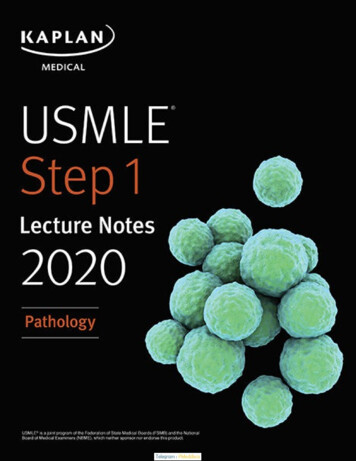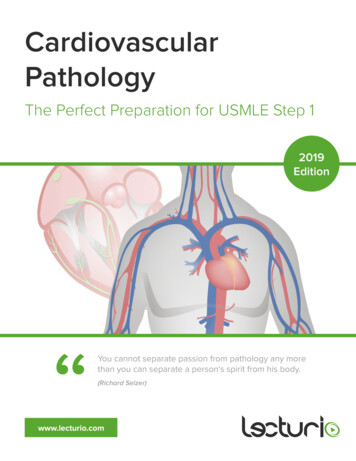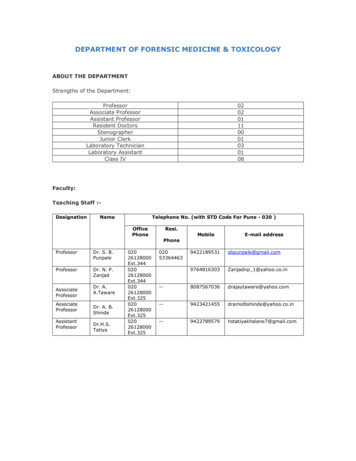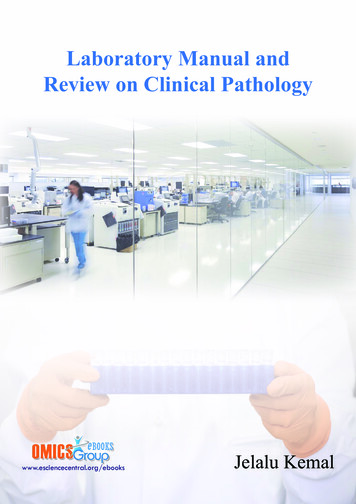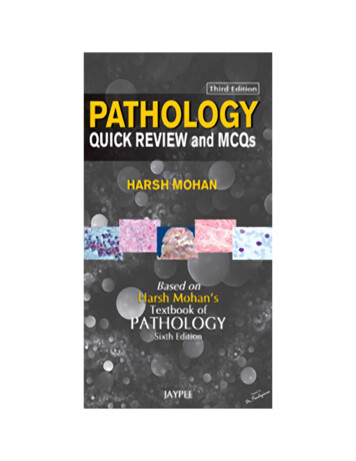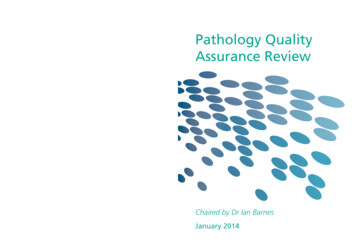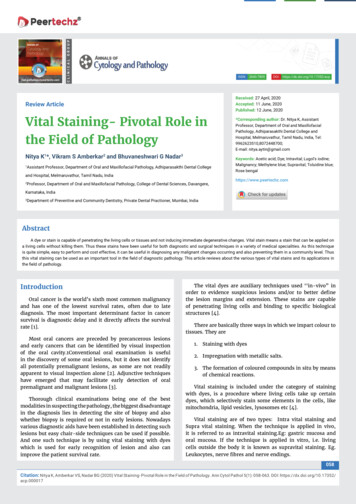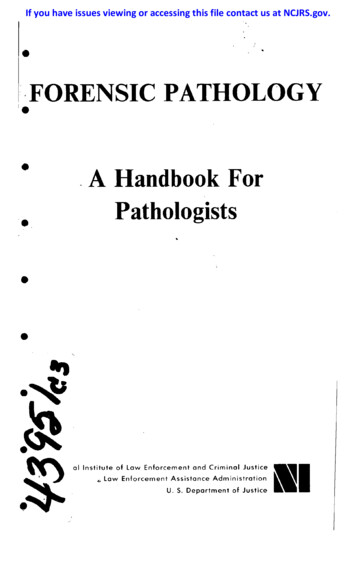
Transcription
If you have issues viewing or accessing this file contact us at NCJRS.gov. FORENSIC PATHOLOGYA Handbook For0.Pathologistsal Institute of Law Enforcement and Criminal JusticeLaw Enforcement Assistance AdministrationU. S. Department of Justice/I
OFORENSIC PATHOLOGYA Handbook ForPathologistsNCJ S Edited ByRUSSELL S. FISHER, M.D.8E001 rtC H A R L E S S. PETTY, M.D.&CQUISBTIO-NS.This project w a s s u p p o r t e d by G r a n t N u m b e r NI 7 1 - 1 l S G a w a r d e dto the C o [ [ e g e of A m e r i c a n Pathologists by the National Institute ofLa v E n f o r c e m e n t a n d C r i m i n a l Justice, L a w E n f o r c e m e n t Assista n c e A d m i n i s t r a t i o n , U.S. D e p a r t m e n t of Justice, u n d e r the Ot nibus C r i m e C o n t r o [ and Safe Streets .Act of 1968, as a m e n d e d .Points of view or opinions stated in this d o c u m e n t are those of thecontributors and do not necessarily represent the official positionor po icies of the U.S. D e p a r t m e n t of Justice.July 1977National Institute of Law Enforcement and Criminal JusticeLaw Enforcement Assistance AdministrationU. S. Department of Justice
For sale by the Superintendent of Documents, U.S. Government Printing OfficeWashington, D.C. 20402Stock Number 027-000-00541-1
CONTENTSContributors.: .PagevF o r e w o r d - - R o b e r t Horn, M.D . . . . . . . . . . . . . . . . . . . . . . . . . . . . .ixPreface by Editors . . . . . . . . . . . . . . . . . . . . . . . . . . . . . . . . . . . . . IIXVIIIXIXXXForensic Autopsy Procedure--Leslie I. Lukash, M.D . . . .Forensic Autopsy: A Procedural O u t l i n e - - F r a n k P.Cleveland, M.D . . . . . . . . . . . . . . . . . . . . . . . . . . . . . . . . .The Autopsy P r o t o c o l - - J o h n F. Barton, M.D. andCharles S. Petty, M.D . . . . . . . . . . . . . . . . . . . . . . . . . . . .Preservation of Medicolegal Evidence Arthur J.McBay, Ph.D . . . . . . . . . . . . . . . . . . . . . . . . . . . . . . . . . .Postmortem Chemistry o f Blood, Cerebrospinal Fluidand Vitreous H u m o r - - J o h n I. Coe, M.D . . . . . . . . . . . . .Time of D e a t h - - T i m e of I n j u r y - - G e o r g e S. Loquvam,M.D . . . . . . . . . . . . . . . . . . . . . . . . . . . . . . . . . . . . . . . . . .Postmortem Changes and Artifacts--Russell S. Fisher,M.D .Identification--Charles J/Stahl, M.D . . . . . . . . . . . . . . . .Sudden Unexpected D e a t h - - J o h n I. Coe, M.D . . . . . . . . .Instantaneous "Physiologic" D e a t h - - C h a r l e s S. Petty,M.D . . . . . . . . . . . . . . . . . . . . . . . . . . . . . . . . . . . . . . . . . .Sudden Infant Death Syndrome (Crib D e a t h ) - - J e r r y T.Francisco, M.D. and Charles S. Hirsch, M.D . . . . . . . . . .The Battered C h i l d - - G e o r g e S. Loquvam, M.D . . . . . . . .R a p e - - - T h e Forensic Pathology Committee, College ofAmerican Pathologists . . . . . . . . . . . . . . . . . . . . . . . . . . .Abortion Russell S. Fisher, M.D . . . . . . . . . . . . . . . . . .Fire V i c t i m s - - J o h n F. Edland, M.D . . . . . . . . . . . . . . . .Electrical Injuries and Lightning--John F. Edland, M . D . .Heat and C o l d - - M i c h a e l M. Baden, M.D . . . . . . . . . . . .The N e c k - - L e s l i e I. Lukash, M.D. and Charles S. Hirsch,M.D . . . . . . . . . . . . . . . . . . . . . . . . . . . . . . . . . . . . . . . . . .Asphyxial D e a t h s - - A l l a n B. McNie, M.D . . . . . . . . . . . .D r o w n i n g - - W i l l i a m G. Eckert, M.D. and Charles S.Hirsch, M.D . . . . . . . . . . . . . . . . . . . . . . . . . . . . . . . . . . .iii171017215056647277838792100104111117119123129
XXIXXII cent Sex Hangings--John F. Burton, M.D . . . . . . .Characteristics of Wounds Produced by Handguns andR i f l e s - - - F r a n k P. Cleveland, M . D . . . . . . . . . . . . . . . . . . .Shotgun W o u n d s - - C h a r l e s S. H i r s c h , M . D . . . . . . . . . . . .Cutting and Stabbing Wounds--Charles J. Stahl, M . D . . .Blunt Trauma: General--Jerry T. Francisco, M . D . . . . . .Page133136144151160Blunt Trauma: Specific Injuries--Michael M. Baden,M.D. and Charles S. Petty, M . D . . . . . . . . . . . . . . . . . . . .Drug Dealhs by Injection--Charles S. Hirsch, M . D . . . . .164168Deaths by Inhalation or Ingestion of Drugs and OtherPoisons--Allan B. MeNie, M . D . . . . . . . . . . . . . . . . . . . .Alcohol--Arthur J. M c B a y , P h . D . . . . . . . . . . . . . . . . . .Therapeutic M i s a d v e n t u r e - - C h a r l e s S. Petty, M . D . . . . . .The Motor Vehicle Crash: Medicolegal Invesfigationm172179185Charles S. Petty, M . D . a n d W i l l i a m G. E c k e r t , M . D . . . . .189A Forensic Library for a Non-Forensic Pathologist-Charles S. Petty, M . D . . . . . . . . . . . . . . . . . . . . . . . . . . . .196iv
CONTRIBUTORSMichael M. Baden, M.D.Deputy Chief Medical ExaminerCity of New YorkAssociate Professor of Forensic MedicineNew York University School of MedicineNew York, New YorkDJohn F. Burton, M.D.Chief Medical ExaminerOakland CountyPontiac, MichiganFrank P. Cleveland, M.D.Coroner of Hamilton CountyDirector, Institute of Forensic Medicine, Toxicology and CriminalisticsAssociate Professor of Forensic PathologyUniversity of Cincinnati College of MedicineCincinnati, Ohio000John I. Coe, M.D.Chief Medical ExaminerHennepin CountyProfessor of PathologyUniversity of Minnesota Medical SchoolChief of PathologyHennepin County General HospitalMinneapolis, MinnesotaWilliam G. Eekert, M.D.Deputy CoronerSedgwich CountyAdjunct Professor of Forensic SciencesWichita State UniversityWichita, KansasJohn F. Edland, M.D.Chief Medical ExaminerMonroe CountyClinical Associate Professor of PathologyUniversity of Rochester School of Medicine and DentistryClinical Assistant Professor of PsychiatryUniversity of Rochester School of Medicine and DentistryRochester, New YorkV
FOREWORDThis publication represents an effort on the part of the College ofAmerican Pathologists to provide the community pathologist with basicinformation in the performance of the medical legal autopsy.The development of the manual was made possible in part throughfunds provided by the National Institute of Law Enforcement andCriminal Justice of the LEAA. The major portion of the funding wasused to conduct 13 seminars in Forensic Pathology attended by morethan 350 community pathologists.The authors of these chapters are all eminently qualified in the fieldof Forensic Medicine and the College extends to them a grateful thankyou for their dedication and efforts to this project.The material presented in this Handbook is not intended to serve asa substitute for existing publications, rather it is intended to serve as anadditional source of information to assist the pathologist in meeting acommunity responsibility.The proper performance of the medical legal autopsy and the objectivepresentation of the findings is a public responsibility which has beenaccepted by many pathologists in this country.It is the hope of the college that this publication will assist you incontinuing your work in this area.Robert Horn, M.D., President,College of American Pathologists9IIixg
P R E F A C E BY EDITORSOur wbrk was easy. We had a fine group of experts in the very broadfield of pathology who did the majOrity of the work in writing thismanual. We have tried to preserve the flavor of each person's style ofwritihg. A few notes have been added to explain different points Of view,but the conterit of the chal ters i epres nts the viewpoint of th individualauthors.Our goal was easy. We Wanted tO help make available tO pathoiogistsa workbook small enoUgh tO be packed in the-ba with the autopsyinstruments; sliort enough td make it possible t6 review any given chapterprior to (or daring) an autopsy,We give it to you--the patologists.We hope yoti find it Useful-----anduse it.Charles S. Petty, M.D.I)allas, TexasRussell S. Fisher, M.D.Baltimore, MarylandXi
Chapter IFORENSIC AUTOPSY PROCEDURELeslie I. Lukash, M.D.Chief Medical ExaminerNassau County, New YorkIntroduction, Concepts and PrinciplesIt is assumed that all pathologists know the construction and requirements for reporting the findings of a complete postmortem examination.The following is a guide for use in converting the standard autopsy protocol into the report of a medicolegal autopsy. All of the usual descriptive technics should be maintained. Greater attention to detail, accuratedescription of abnormal findings, and the addition of final conclusionsand interpretations, will bring about this transformation.The hospital autopsy is an examination performed with the consent ofthe deceased person's relatives for the purposes of: (1) determining thecause of death; (2) providing correlation of clinical diagnosis and clinicalsymptoms; (3) determining the effectiveness of therapy; (4) studying thenatural course of disease processes; and (5) educating students andphysicians.The medicolegal autopsy is an examination performed under the law,usually ordered by the Medical Examiner and Coroner 1 for the purposesof: (1) determining the cause, manner, 2 and time of death; (2) recovering, identifying, and preserving evidentiary material; (3) providing interpretation and correlation of facts and circumstances related to death;(4) providing a factual, objective medical report for law enforcement,prosecution, and defense agencies; and (5) separating death due todisease from death due to external causes for protection of the innocent.The essential features of a medicolegal autopsy are: (1) to perform acomplete autopsy; (2) to personally perform the examination and observeall findings so that interpretation may be sound; (3) to perform athorough examination and overlook nothing which could later prove ofimportance; (4) to preserve all information by written and photographicrecords; and (5) to provide a professional report without bias.Editors note: In some jurisdictions the health officer, district attorney or othersmay order an autopsy.Editors note: Sometimes referred to as "mode" of death.
Preliminary ProceduresBefore the clothing is removed, the body should be examined to determine the condition of the clothing, and to correlate tears and otherdefects with obvious injuries to the body, and to record the findings. Theclothing, body, and hands should be protected from possible contamination prior to specific examination of each. A record of the general condition of the body and of the clothing should be made and the extent ofrigo r and lividity, the temperature of the body and the environment, andany other data pertinent to the subsequent determination of the time ofdeath also should be recorded.After the preliminary examination the clothing may be carefully removed by unbuttoning, unzippering, or unhooking to remove withouttearing or cutting. If the clothing is wet or bloody, it must be hung upto dry in the air to prevent putrefaction and disintegration. Record andlabel each item of clothing. Preserve with proper identification for subsequent examination. Clothing may be examined in the laboratory withsoft tissue x-ray and infrared photographs in addition to various chemicalanalyses and immunohematologic analyses.Autopsy Procedure-The.date, time and place of autopsy should be succinctly noted,and where and by whom it was performed, and any observers or participants should be named. The body should be identified, and all physical characteristics should be described. These include age, height, weight,sex, color of hair and eyes, state of nutrition and muscular development,scars,, and tattoos. Description of the teeth, the number present andabsent, :and the general condition should be detailed noting any' abnormalities or deformities, or evidence of fracture, old or recent. In aseparate paragraph or paragraphs describe all injuries, noting the numberand characteristics of each including size, shape, pattern, and locationin relation t o anatomic landmarks. Describe the course, direction, anddepth.of injuries and enumerate structures involved by the injury. Identifyand label any'foreign object recovered ,and specify its relation to a giveninjury : ,. :At' least one photograph should be taken to identify the body.Photograph injuries to document their location and be certain to, includea 'scale to show their size. Photographs can be used to demonstrate andcorrelate, external injuries with internal injuries and to demonstratepathologic processes other than those of traumatic origin.' Roentgenographic and fluoroscopic examinations tan be used to locatebullets or other radio-opaque objects, to identify the victim, and tOdocument fractures, anatomic deformities, and surgical procedures whensuch metallic.foreign bodies as plates, nails, screws, a n d wire sutureshave been used.A general description of the head, neck, cervical spine., thorax, abdo2
men, genitalia, and extremities should be given in logical sequence. Thecourse of wounds through various structures should be detailed remembering variations of position in relationships during life versus relationships after death and when supine on the autopsy table. Evidentiaryitems such as bullets, knives, or portions thereof, pellets or foreign materials, should be preserved and the point of recovery should be noted.Each should be labelled for proper identification. Each organ should bedissected and described, noting relationships and conditions.Special E x a m i n a t i o n s and D i s s e c t i o n T e c h n i c sH e a d . First examine the exterior of the scalp for injury hidden by thehair and the interior of the scalp for evidence of trauma not visibleexternally. Note the course and extent of fractures. When removing thecalvarium keep the dura intact (subdural hemorrhage can thus be preserved for measurements). Strip dura from the calvarium to expose anyfractures. Use a dental chart to specifically identify each tooth its condition, the extent of caries and location of fillings. 3 Note the absence ofany teeth. Examine both the upper and lower eyelids for petechialhemorrhages and the eyes for hidden wounds. Examine the ear canalsfor evidence of hemorrhage indicative of fracture. Examine the interiorof the mouth, lips, and cheeks for evidence of trauma.N e c k . External examination of the neck should include observationof all aspects for contusions, abrasions, or petechiae. Manual strangulation is often characterized by a series of linear or Curved abrasions andcontusions. Ligature strangulation is characterized by a linear abrasionand some ligatures may produce definitive patterned abrasions. Ligaturestrangulation generally produces linear abrasion in a. horizontal plane.Hanging characteristically produces a deep grooved abrasion with a ninverted " V " at the point of suspension and a pattern .may. also be produced. Indistinct or obscure external injuries may become more apparentat completion of autopsy after blood has drained and the tissues beginto dry. For internal examination of the neck dissect the chest flapupward to the level of the chin, expose the neck muscles and organs afterthe neck vessels have been drained of blood by removal o f : t h e heart.Note the location of hemorrhage into muscles. Hemorrhage will .begreatest 'in manual strangulation or severe blunt trauma of. the neck.Remove the neck organs intact including the tongue. Dissect with extreme care so as not to break the hyoid bone during, removal and dissectthe muscles from the bone. Hemorrhage will be noted at. the Site: offracture. Thyroid or cricoid cartilages may also be fractured'in manualstrangulation and hemorrhage will be n o t e d at the site of" these f r a c tures. The mucosa of the larynx, pyriform sinuses; and esophagus mayshow petechiae or hemorrhage. Examine the cervical sl ine anteriorly3 Editors note: In those cases where dental description is of crucial importance, adentist may be of great assistance.
for hemorrhage in the muscles along the vertebrae. Hemorrhage will bepresent at the site of fractures of the cervical vertebrae. When vertebraeC-1 and C-2 are fractured dissection should be carried out from theposterior approach. The characteristic signs of asphyxia are cyanosis,petechiae in the conjunctivae, sclerae, eyelids, face, neck, upper chest,and internally in the pericardium, epicardium, and pleurae.Cervical and thoracic spine. The cervical spine may be examinedanteriorly or posteriorly. High cervical injuries are best demonstratedby the posterior approach. The thoracic spine may be readily examinedfrom the interior (anterior) approach. Identify the specific injured vertebrae. Note any fracture, dislocation, compression, or evidence of hemorrhage at the site. Dissect the soft tissue and muscle from the surface inorder to view the vertebral bodies. Small projectiles may enter vertebraeby splitting fibers and leave little obvious evidence of entrance. Openthe spinal canal. Remove the cord to demonstrate any injury.Chest. Detail fractures of ribs. Cardiopulmonary resuscitation accountsfor many fractures of ribs and sternum. Use caution in opening thechest so as to preserve evidence of pneumothorax and air embolism.Air embolism is usually made obvious by distention of the heart and thepresence of frothy fluid within the cardiac chambers and peripheralvessels. Record the quantity of fluid or blood within the pericardial sacand pleural cavities. Caution: Never discard fluid recovered from bodycavities until after all known foreign objects or projectiles have beenlocated.Abdomen. Note the relationships of organs one to another. Measureany fluid present. Trace the course of injuries prior to removal of theorgans. Preserve the gallbladder and urinary bladder intact to have thefluids available for toxicologic specimens if necessary. Remove the alimentary tract intact to prevent possible contamination of other viscerain case it is necessary to preserve organs for toxicologic examination.Attempt to locate projectiles prior to removal and dissection of organs.Extremities. In all suspicious and all homicidal deaths, the handsshould be protected from contamination by being covered with plasticbags. 4 The lateral surfaces of the arms, extensor surfaces of the forearms,and dorsal aspects of the wrists and hands should be examined in detailfor evidence of defense wounds. Incised wounds of the palmar aspects ofthe hands and fingers are frequently seen in cases of stabbing. Observeeach finger for evidence of broken fingernails or broken fingers. Traceevidence may be recovered from beneath fingernails; however, careshould be taken not to inadvertently include tissue from the victim. Thehands may be examined for powder residue employing neutron activationanalysis or atomic absorption technics. Powder residue or blast injuries4 Editors note: Paper bags are sometimes preferable, particularly if the body is tobe stored in cool temperatures. Less "sweating" or moisture condensation occurs.4
may be noted on hands. Palmar aspects of hands and fingers may beexamined by trace metal detection technics.External genitalia. Examine for evidence of foreign material such assemen. Note any abrasions or contusions, their size, location, and number, and include evidence of injury along intertriginous surfaces of thethighs. To collect foreign hair samples use a fine comb to remove allloose hairs. Collect the hairs and place in identified containers. Aspiratefluid from vaginal canal for determination of acid phosphatase and bloodgroup substance and examination for spermatozoa. Record obvious injury as possible source of hemorrhage.Internal genitalia. Examine and describe the organs in situ. Removecarefully with blunt and sharp dissection using extreme care not to useinstruments upon the cervix, which might confuse injuries produced byinstrumentation on the cervix and uterus. Note and preserve any fluidor foreign material within cervix, uterus, or vagina.Special ProceduresCollection o f specimens. Have a variety of containers to meet individual requirements, such as, solid material, fluid material, and foreignobjects. Collect tissue and fluids for chemical analysis in chemicallyclean containers. Identify each specimen as to organ or fluid. Labelwith the name of the deceased, the date, and the name of the examiner.Seal and store in the refrigerator or freezer. Hair samples may be obtainedby plucking to secure entire hairs including roots. Obtain representativesamples from several areas, and label each as to source, such as scalpor pubis. Take a sample of blood directly from the heart after openingthe pericardial sac. A minimal sample is 100 ml. In cases of drowningtake individual samples from both the right and left sides of the heart.Obtain all urine and bile that is available. Obtain adequate quantities ofvisceral organs and place each in a pint jar or equivalent container. Obtainsamples from the stomach and small intestine, and identify individually.Preserve the chain of evidence by maintaining absolute control ofspecimens.Observations relating to determination of the time of death include:(1) the stage of rigor mortis; (2) the degree, location, and fixation ofpostmortem lividity or livor mortis; (3) skin slippage, postmortemsuggillations; (4) temperature of the body and viscera; (5) condition ofthe alimentary tract, the presence or absence of food, and the stage ofdigestion; (6) foreign items such as fly eggs or maggots; and (7) postmortem artifact or tissue destruction. These postmortem or putrefactivechanges are secondary to the effect of scavenger insects and animals.On the scene examinations may be helpful when possible to personallyobserve circumstances and conditions relating to the body.Pitfalls that may be encountered include: the failure to make any ofthe preceding observations; the assumption of the cause of death and
failure to perform a complete autopsy; and the determination of time ofdeath versus time of infliction of the fatal injury. An individual maysustain a fatal injury and survive for a long period of time prior to death.
Chapter IIFORENSICAUTOPSY:A PROCEDURALOUTLINEFrank P. Cleveland, M.D.Coroner, County of HamiltonCincinnati, Ohio1. Introduction, Concepts, and Principlesa. Definition of medicolegal autopsy. The medicolegal autopsy isdifficult to define. Basically, it is an autopsy carried out underthe laws of the State for the protection of its citizens. As such,the performance of the autopsy presupposes State, not individualpermission. T h e importance to the State transcends the usualindividual right to sepulcher until after the autopsy is completed.b. Reasons for performing a medicolegal autopsy.(1) To determine cause and manner of death.(2) To approximate time of death.(3) To identify, collect, and preserve physical evidence.(4) To provide factual information to law enforcement agencies,prosecutors , defense attorneys, families, news media andothers with need to know.(5) To protect the innocent as well as to assist in the identification and prosecution of the guilty.c. Requirements.( 1 ) Complete autopsy, no exceptions.(2) Thorough examination, overlook nothing.(3) Factual, objective written report without prejudice, advocacy, or theory.2. Preliminary steps.a. Examine the body before removal of the clothing.b. Protect the clothing, body and hands from contamination; preserve clothing for examination at a later time.c. Note general state of thebody. 'd. Observe the state of rigor and lividity.e. Determine the body temperature if applicable and other detailsas necessary to relate to the time of death.3. Autopsy procedures.a. Note time and place of autopsy examination.7
b. External examination: apparent age, height and weight, state ofnutrition, scars, tattoos, color of eyes and hair, teeth, musculardevelopment, abnormalities, deformities, and marks of hospitalization.c. Detailed examination of injuries: size, shape, location, pattern,and relationship to anatomic landmarks.d. Photographs.(1) To identify deceased.(2) To document injuries and their location (include scale forcomparison).(3) To show relationship of external and internal injuries.(4) To demonstrate pathologic processes other than those oftraumatic origin.e. X-ray and fluoroscopic examination.( 1 ) To locate bullets or other radiopaque objects.(2) To identify victim.(3) To document old fractures, recent fractures, anatomic deformities, metallic foreign bodies, plates, nails, and screwsfrom surgical procedures, etc.f. Internal examination.(1) General examination of head, neck, cervical spine, thorax,and abdomen.(2) Note course and direction of wound tracks within the bodyand in relationship to specific organs.(3) Note relationships and conditions of viscera.(4) Remember that antemortem and postmortem relationshipsof wounds and viscera may not always be the same.(5) Preserve evidence. Recover and identify foreign objects(bullets, fragments of knives, etc.); label and establish chainof custody.g. Orderly examination of the body cavities and viscera. Procedures frequently used in forensic autopsies.a. Collection of specimens.( 1 ) Hair from scalp and pubis.(2) Comb pubic hair for foreign hairs.(3) Collect specimens of blood, urine, and bile.(4) Collect specimens of viscera, and body secretions.(5) Collect any likely material for examination to determinepresence of semen and sperm.(6) Place specimens in chemically clean containers.(7) Store in refrigerator or freezer.(8) Properly identify and label specimens.(9) Preserve "chain of evidence"--control of specimens.b. Clothing.( 1 ) Examine prior to removal.
c.(2) Correlate defects with bodily injuries.(3) Remove and air dry if wet.(4) Label and preserve.Observations relating to estimation of time of death.(1) Rigor.(2) Lividity.(3) Temperature of viscera.(4) State of digestion of any food in the stomach.(5) Amount of urine in the bladder.(6) State of decomposition.(7) Fly eggs, fly larvae (maggots), and other insect activitypresent.5.Postmortem artifacts.a. Artifacts of decomposition.b. Third party artifacts.(1) Animal activity: arthropophagy.( 2 ) Insect activity: anthropophagy.(3) Emergency medical treatment in agonal and postmortemstate.(4) Deliberate mutilation: dismemberment, etc.c. Artifacts of environment.(1) Postmortem burning.(2) Postmortem corrosion.(3) Postmortem maceration.d. Other artifacts.Artifacts of storage prior to examination.6.Cautions.a. Do not fail to make any of the preceding observations.b. Do not assume the cause of death prior to actual completion ofthe autopsy?c. Do not confuse time of death with time of inflication of fatal injury.1 Editors note: The autopsy is not over when the body leaves the autopsy room.At that point, toxicologic and histologic examination has just begun. Investigationaldata of great correlative importance may not yet be available to the prosecutor.Avoid premature dogmatic statements until all findings can be examined and correlated.
Chapter HITHE AUTOPSY PROTOCOLJohn F. BurtOn, M.D.Chief Medical Examiner of Oakland CountyPontiac, MichiganandCharles S. Petty, M.D.Chief Medical Examiner, Dallas CountyDirector of Institute of Forensic SciencesDallas, TexasIntroductiOnNarrative versus numerical form. A prbtocbl is a signed documentcontaining a written record which serx,es as proof of something. Inp ithology it is used in two basic forms the narrative (in story form)and the numerical (by the numbers). Each form has its advantages andits disadvantages depending entirely upon the personal views and abilitiesof the individual prosecutor and his account of the autopsy findings;nonetheiess, the end result using either form should be an accuraterecord of the autopsy findings.1. The narrative forma. Advantages(1) For those of Us who ai'e very able at telling stories, thenarrative protocol is balm to the reader and can be madepoetic.i2) It provides an immediate storage of the facts on tape as itig dictated.(3) The pathologist is able tO demonstrate, through narration,his personal attention and expertise by showing differencesbetween normal and abno nal appearances.b. Disadvantagds(1) The prosecutor cah eventually be lulled into a repetitiousform of dictation--"habit"--in which, except for summaryof findings, all his protocols read alike and leave little roomfor individuality except for the final findings or diagnoses.(2) The narration of many pathologists is sketchy and sentencestructure is incomplete with disconnected facts and descrip-0
tion of immaterial data wl ich in the finale reveals nothinginformative. (Cross-examination of the pathologist on th witness stand regarding such a protocol is simply mayhem.)(3) This type of protocol is not amenable to easy correctionprior to typing the final or "smooth" copy.(4) The narrative protocol tends to be both personal and subjective, neither of Which are desirable features for courtroompurposes.(5) It requires an expensive type of assistance: secretarial. Thereis a tendency for busy services to allow untranscribed protocols to collect and to become an Unwieldy backlog.Ix2. The numerical protocola. Advantages(1) It provides a guide for an orderly description of all autopsyfindings and tends to prevent the omission of minor details,at times forgotten during narration.(2) It provides a Uniformity of detailed information on all cases.(3) It facilitates immediate inspection of any particular heading,featiire, or organic lesion found at autopsy.(4) It is objective and impersonal, both desirable features inforensic practice.(5) It is amenable to correction prior to final typing (if it is tobe typed.)b. Disadvantages(1) Completion of the numerical pro.tocol may require moretime than the dictation of a narrative form.(2) The format is not applicable to mummies, skeletons, unknown bones, four-footed animals and bi
used to conduct 13 seminars in Forensic Pathology attended by more than 350 community pathologists. The authors of these chapters are all eminently qualified in the field of Forensic Medicine and the College extends to the
